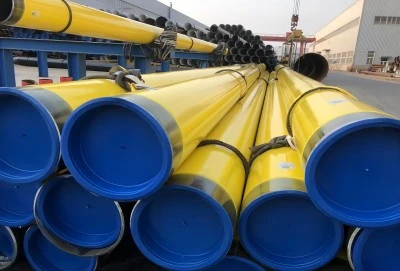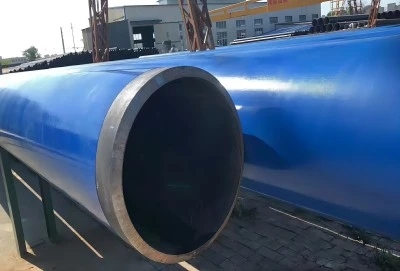Ensuring the quality and proper thickness of fusion bonded epoxy coated steel pipes is crucial for their long-term performance and durability. This comprehensive guide will walk you through the essential methods and techniques used to assess the quality and measure the thickness of FBE coatings on steel pipes. By understanding these processes, you'll be better equipped to select and maintain high-quality coated pipes for your projects.
|
|
|
Coating Thickness Measurement
Accurately measuring the thickness of fusion bonded epoxy (FBE) coatings is a critical step in quality control. The coating thickness directly impacts the pipe's corrosion resistance and overall performance. Here are some methods commonly used to measure FBE coating thickness:
1. Magnetic Thickness Gauges
Magnetic thickness gauges are non-destructive tools that use magnetic fields to measure coating thickness. These devices are easy to use and provide quick, accurate readings. To use a magnetic thickness gauge:
- Clean the pipe surface to remove any dirt or debris
- Calibrate the gauge using a calibration standard
- Place the gauge probe perpendicular to the pipe surface
- Take multiple readings at different points around the pipe circumference
- Calculate the average thickness from the readings
2. Ultrasonic Thickness Gauges
Ultrasonic thickness gauges use high-frequency sound waves to measure coating thickness. These devices are particularly useful for thicker coatings or when access to both sides of the pipe is limited. To use an ultrasonic thickness gauge:
- Apply a coupling gel to the pipe surface
- Calibrate the gauge using a known thickness standard
- Place the transducer on the pipe surface
- Record the thickness reading displayed on the gauge
- Take multiple measurements at various locations
3. Destructive Testing Methods
While less common due to their invasive nature, destructive testing methods can provide highly accurate thickness measurements. These methods involve cutting a small section of the coated pipe and examining it under a microscope. This approach is typically reserved for research purposes or when disputes arise regarding coating thickness.
When measuring FBE coated steel pipe thickness, it's essential to consider the following factors:
- Pipe geometry: Curved surfaces may affect measurement accuracy
- Surface roughness: Rough surfaces can influence readings
- Coating uniformity: Thickness may vary across the pipe surface
- Environmental conditions: Temperature and humidity can impact measurements
Adhesion Test
The adhesion of the FBE coating to the steel pipe is crucial for long-term performance and corrosion protection. Poor adhesion can lead to coating failure and accelerated corrosion. Here are some methods to evaluate the adhesion of FBE coatings:
1. Cross-Cut Adhesion Test
The cross-cut adhesion test is a simple yet effective method to assess coating adhesion. To perform this test:
- Use a sharp cutting tool to make a series of parallel cuts through the coating
- Make a second set of cuts perpendicular to the first, creating a grid pattern
- Apply adhesive tape over the grid and remove it quickly
- Examine the grid for any coating removal or peeling
- Rate the adhesion based on the amount of coating removed
2. Pull-Off Adhesion Test
The pull-off adhesion test provides a quantitative measure of coating adhesion strength. This method involves:
- Attaching a loading fixture (dolly) to the coating surface using an adhesive
- Allow the adhesive to cure fully
- Using a hydraulic actuator to apply increasing force to the dolly
- Recording the force required to detach the coating from the substrate
- Examining the failure mode (adhesive or cohesive)
3. Knife Adhesion Test
The knife adhesion test is a quick field method to assess coating adhesion. To perform this test:
- Use a sharp utility knife to make a V-cut through the coating to the substrate
- Attempt to lift the coating from the V-cut using the knife blade
- Observe the ease of removal and any coating delamination
- Rate the adhesion based on the difficulty of removal and coating behavior
When evaluating adhesion of epoxy coated carbon steel pipe, consider these factors:
- Surface preparation: Proper surface cleaning and preparation are crucial for good adhesion
- Coating application conditions: Temperature and humidity during application can affect adhesion
- Curing time: Ensure the coating has fully cured before testing
- Pipe material: Different steel grades may exhibit varying adhesion properties
Corrosion Resistance Evaluation
Assessing the corrosion resistance of FBE coated pipes is essential to ensure their long-term performance in challenging environments. Here are some methods to evaluate corrosion resistance:
1. Salt Spray Testing
Salt spray testing simulates a corrosive marine environment to evaluate coating performance. The process involves:
- Placing coated pipe samples in a salt spray chamber
- Exposing the samples to a continuous salt fog for a specified duration
- Periodically inspecting the samples for signs of corrosion or coating degradation
- Evaluating the extent of corrosion and coating failure after the test period
2. Electrochemical Impedance Spectroscopy (EIS)
EIS is a non-destructive technique that provides detailed information about coating performance and corrosion protection. This method involves:
- Immersing the coated pipe sample in an electrolyte solution
- Applying a small AC voltage across the coating
- Measuring the resulting current response
- Analyzing the impedance data to assess coating integrity and corrosion resistance
3. Cathodic Disbondment Test
The cathodic disbondment test evaluates the coating's resistance to degradation under cathodic protection conditions. To perform this test:
- Create a small holiday (defect) in the coating
- Immerse the sample in an electrolyte solution
- Apply a cathodic potential to simulate cathodic protection
- Maintain the test conditions for a specified period
- Measure the extent of coating disbondment around the holiday
4. Chemical Immersion Testing
Chemical immersion testing assesses the coating's resistance to specific chemicals or environments. This method involves:
- Immersing coated pipe samples in various chemical solutions
- Maintaining the samples at elevated temperatures if required
- Periodically inspecting the samples for signs of coating degradation
- Evaluating changes in coating properties after exposure
When assessing the corrosion resistance of fusion bonded epoxy coated steel pipe, consider these factors:
- Environmental conditions: Test conditions should simulate the intended service environment
- Coating thickness: Ensure consistent coating thickness across test samples
- Edge effects: Properly seal sample edges to prevent unrealistic results
- Test duration: Long-term testing may be necessary for accurate performance prediction
By thoroughly evaluating the coating thickness, adhesion, and corrosion resistance of FBE coated steel pipes, you can ensure the selection of high-quality products that will provide long-lasting protection in various applications. Regular inspection and testing throughout the pipe's service life can help identify potential issues early and extend the overall lifespan of your pipeline infrastructure.
For expert assistance in selecting and evaluating FBE coated steel pipe for your project, don't hesitate to reach out to our team of specialists at info@longma-group.com. We're here to help you make informed decisions and ensure the success of your pipeline projects.














